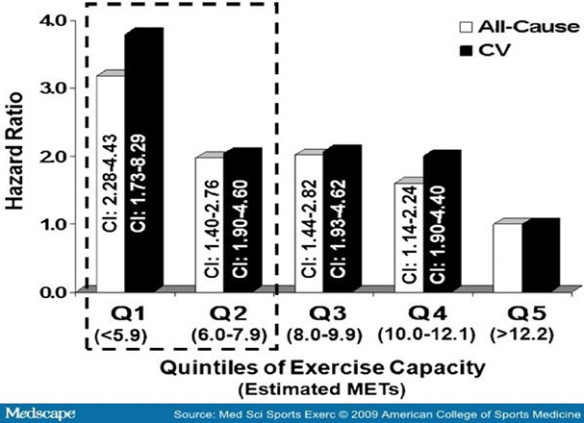
Today we are going to start on the second pillar of the wellness formula – exercise.
I heard a rumour, recently that the Pharma industry was working on a pill to replace exercise! Man, have they got a job ahead of them!
Let’s look at what they would have to achieve.

How much exercise do you really need?
The answer to this question is, in a way surprising. Please take a look at Table #1.
This table plots Hazard Ratio (mortality) against Exercise Capacity. Just zero in on the first two (Q1 & Q2). You will see immediately that there is a huge reduction in both All Cause mortality and Cardiovascular mortality in simply progressing from Q1 (sedentary) to Q2 (mild to moderate exercise). Surely this is a powerful message. Just do it!

How do you start?
The simplest way to begin is to start walking. You can walk on your own timetable, there is no economic barrier and there is no required equipment.
Now, get this. I said walk, I didn’t say dawdle, chat with the neighbours or drop in to your local market. Walk, head high, belly in and boogie for 45 minutes – several days a week to begin. This is your initial goal. Establish the pattern of exercise.

That’s all I want you to get from this article. Get out there.
Get walking daily. Establish a good cardiovascular base.
Remember Table 1. The All Cause and Cardiovascular mortality advantages are truly amazing.
So What’s Next?
In my next Journal post we will begin to look at taking the exercise prescription to the next level. We will talk about heart rate, heart rate monitors, interval training and intense exercise. (Those of you who hate exercise will love this one!).
I’ll leave you with a clue as to what we are striving for.
Until then, get out there, get walking!

Aerobic vs. Anaerobic Exercise
Exercise falls into two basic categories: aerobic and anaerobic. Aerobic exercise involves muscle movement that uses oxygen to burn both carbohydrates and fats – producing energy. Anaerobic exercise involves muscle movement that does not require oxygen, burning carbohydrates to produce energy.
Aerobic exercise includes activities such as walking, bicycling or swimming that temporarily increase your heart rate and respiration. Aerobic exercise (also known as cardiovascular exercise) helps build endurance.
Anaerobic exercise includes activities such as weightlifting, push-ups or sit-ups, building muscle and physical strength through short bursts of more strenuous activity. An well-balanced exercise program should include both aerobic and anaerobic exercise.
Salad for 2: Penelope’s Garden Green Mix
Starting with this Journal post – I will include a new healthy ‘anti-aging’ recipe with every article that you can enjoy at home. You can also download this recipe in PDF format.
Ingredients:
2 handfuls of Mixed baby greens
8 Grape tomatoes – cut in half
2 Green onion
¼ handful Red onion
¼ handful Red pepper
½ handful Green apple
½ handful Pink grapefruit
½ handful Blood orange
1 handful Organic raisins
¼ handful Organic cucumber
1 handful Organic mixed nuts
1 tablespoon Dried fruit
Extra virgin olive oil (to flavour)
Balsamic fig vinegar (to flavour)
1 teaspoon of crumbled Goat feta
1 handful Chopped parsley
4-6 leaves Chopped basil
2 teaspoons Thyme
Prep time: 45 minutes / Serves 2
Serve with pan-fried sole fillets, roast chicken breast, smoked salmon or black beans.
Ask a Question?
I will be happy to answer any questions that you may have, related to this Journal article. I will post my answers to the 10 most frequently asked questions on the website.
Please take a moment to Subscribe to my free Health & Wellness Newsletter to receive monthly updates and exclusive content for members.
